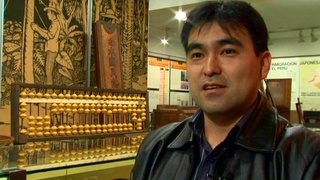Interviews
Brazilian of Japanese descents (Portuguese)
(Portuguese) Well, I don’t think it’s possible for us to separate, right? With our appearance, you can’t separate yourself and say, “I’m not Nikkei.” Not only because people, society, everyone who’s around you demands it. They very often call out, “Hey, Japanese, Japanese.” In reality they’re calling your Nikkei side, right.
So, I think that at a certain point in my life, and I can tell you that it was as a young person, we struggle a lot with this thing of being of Japanese descent. You enter the general society, right, in this case Brazilian society, and you want to be Brazilian like everybody else. In truth, I believe that because you are Nikkei, you do have some unique qualities, you have a culture that you inherited from your ancestors. So then, at a certain point, this becomes a strong influence in your life, right. And then my work, you know, has always been connected to the Japanese community. But, I just don’t think you can separate it. For me personally, I couldn’t separate it because I’d always be in conflict with myself.
So I think the great challenge in my life, from the time I was a young person all the way to the present, is how to bring these two sides together, and how to use these two parts in a creative way. In a way that contributes to society or to culture in general.
Date: October 7, 2005
Location: California, US
Interviewer: Ann Kaneko
Contributed by: Watase Media Arts Center, Japanese American National Museum.
Explore More Videos

Diverse membership in San Jose Taiko
Co-founder and creative director of San Jose Taiko

Looking at your country from the outside
(b.1942) Japanese American ceramist, who has lived in Japan for over 30 years.

Wife's family in Japan
(b.1942) Japanese American ceramist, who has lived in Japan for over 30 years.

Lack of notion of citizenship in Japan
(b.1935) American born Japanese. Retired businessman.

Generational Change (Spanish)
(b. 1974) Director of Ryukyu Matsuri Daiko in Peru

Lack of language skills
(b.1964) California-born business woman in Japan. A successor of her late grandmother, who started a beauty business in Japan.

Preserving traditional Japanese culture
(b.1964) California-born business woman in Japan. A successor of her late grandmother, who started a beauty business in Japan.

Having patience in Japan, being both
(b.1964) California-born business woman in Japan. A successor of her late grandmother, who started a beauty business in Japan.


Being on the outside
(b.1948) Nikkei from Southern California living in Japan.

His parents' experience with Japanese resistance toward intermarriage with Okinawans
(b.1925) Nisei of Okinawan descent. Had a 38-year career in Japan as a baseball player, coach, scout, and manager.

Working in cane fields as teenager, and how it helped in his athletic training (Japanese)
(b.1925) Nisei of Okinawan descent. Had a 38-year career in Japan as a baseball player, coach, scout, and manager.

Nickname
(b.1913) Kibei from California who served in the MIS with Merrill’s Marauders during WWII.

Mixed emotions after declaration of war on Japan
(b.1913) Kibei from California who served in the MIS with Merrill’s Marauders during WWII.

Growing up in Waikiki
(b. 1924) Political scientist, educator, and administrator from Hawai`i
